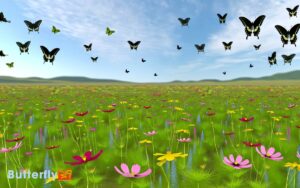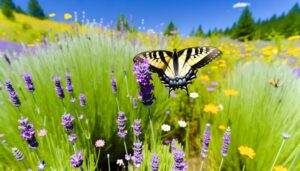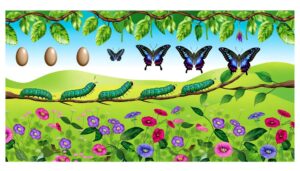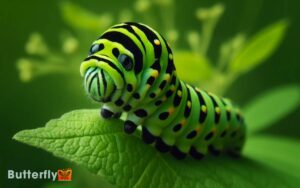How to Observe the Life Cycle of the Yellow Swallowtail Butterfly in Your Backyard
The life cycle of the Yellow Swallowtail Butterfly (Papilio glaucus) begins with females laying pale green eggs on host plants like wild cherry, which hatch in 4-10 days. Larvae undergo several molting stages, evolving from small, black instars to larger, colorful caterpillars feeding on Apiaceae plants.
As larvae mature, they enter the pupal stage, forming a chrysalis where metamorphosis occurs through histolysis and histogenesis. The adult butterfly emerges with crumpled wings, which harden as hemolymph is pumped into them.
Adults focus on mating and reproduction, attracted to specific nectar sources for nourishment. Learn more about its fascinating life cycle intricacies.
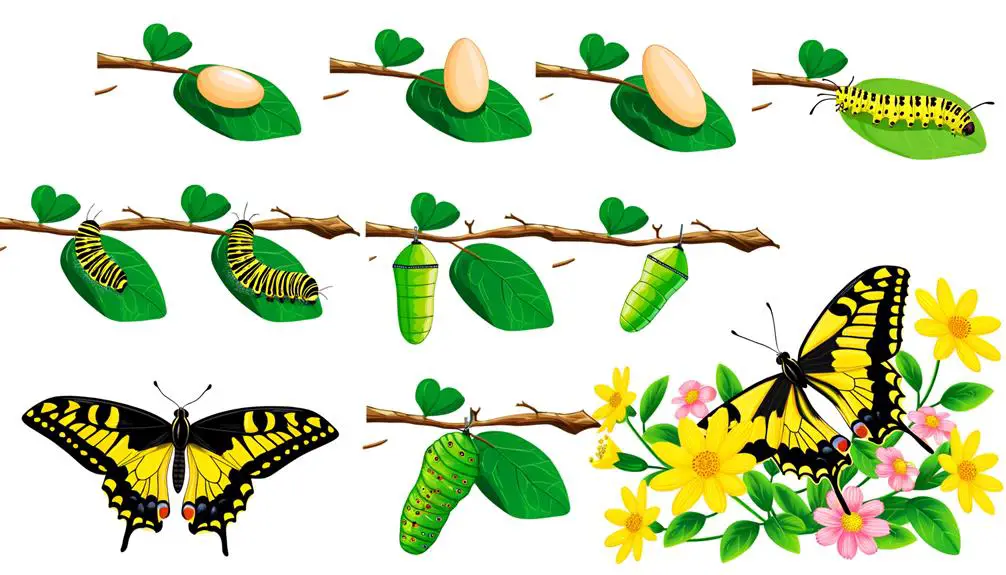
Key Takeaways
- Female Yellow Swallowtail butterflies lay eggs singly on host plants like wild cherry or tulip trees.
- Larvae undergo multiple molting phases, increasing in size and changing appearance with each instar.
- The larval diet primarily consists of plants from the Apiaceae family, which are vital for their growth and defense.
- The pupal stage involves metamorphosis within a protective chrysalis, transforming larval tissues into adult structures.
Egg Stage
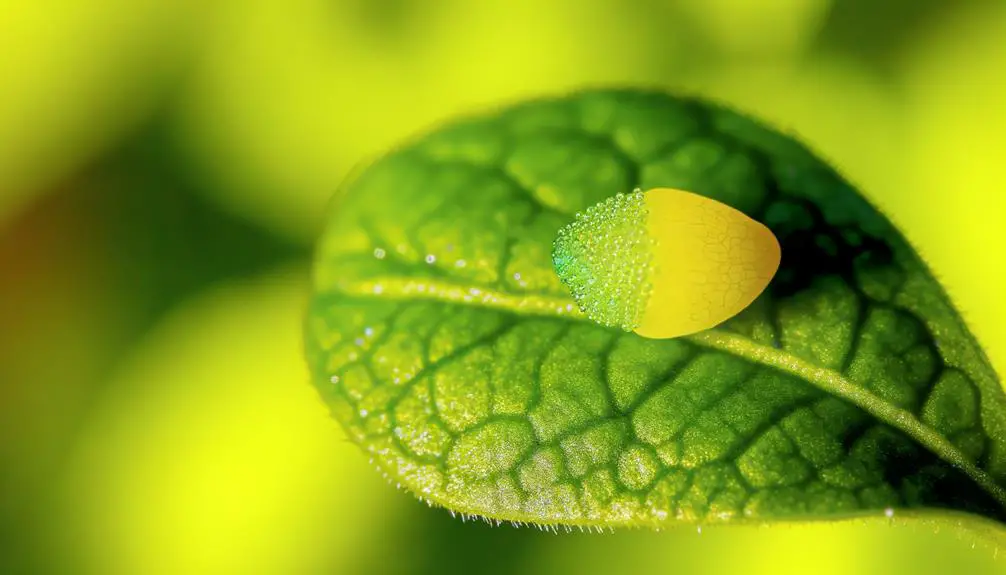
The egg stage of the Yellow Swallowtail butterfly (Papilio glaucus) begins when the female deposits her tiny, spherical eggs singly on the leaves of host plants, such as wild cherry or tulip trees.
These eggs, typically measuring about 1.2 mm in diameter, exhibit a pale green hue, blending seamlessly with the foliage. The exterior surface is smooth, which aids in reducing predation by making them less conspicuous.
Research indicates that the choice of oviposition sites is influenced by the presence of specific chemical cues emitted by the host plants.
The eggs remain in this stage for approximately 4-10 days, depending on ambient temperature and humidity conditions. This period is critical for embryonic development, setting the stage for the subsequent hatching process.
Hatching Process
As the embryonic development within the eggs reaches completion, intricate biochemical and physiological changes trigger the emergence of the larval stage in the Yellow Swallowtail butterfly.
The enzyme chorionase is secreted, weakening the eggshell or chorion. This enzymatic activity facilitates the larva's escape from the confines of the egg. The caterpillar, equipped with specialized mandibles, begins to chew through the softened eggshell.
Upon hatching, the first instar larva typically consumes the remnants of the eggshell, a behavior termed 'oviphagy.' This process guarantees an immediate intake of essential nutrients, promoting initial growth and development.
The hatching process, meticulously timed, aligns with ideal environmental conditions, guaranteeing the larva's survival and subsequent progression through its life cycle stages.
Larval Growth
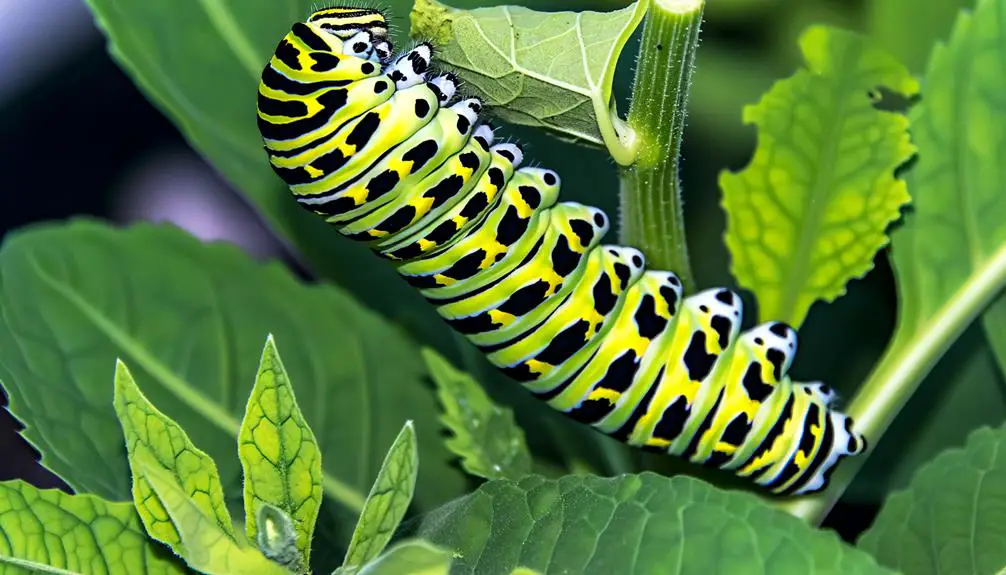
Following hatching, the Yellow Swallowtail larva, or caterpillar, begins a rigorous growth phase characterized by successive molting events known as instars. During this phase, the caterpillar undergoes significant morphological changes and size increments.
Key stages of larval growth include:
- First Instar: Newly hatched larvae are small, black, and covered with fine hairs.
- Second Instar: The caterpillar grows larger and develops a distinctive pattern of white, black, and red.
- Third Instar: The larva continues to increase in size, with more pronounced color changes and pattern development.
- Fourth Instar: The caterpillar reaches its largest size, preparing for the next stage of metamorphosis.
Each instar is critical for the caterpillar's development, ensuring successful shift to subsequent life stages.
Feeding Habits
In their larval stage, Yellow Swallowtail caterpillars primarily feed on plants from the Apiaceae family, such as parsley, fennel, and dill, which provide essential nutrients for their rapid growth and development.
These host plants contain a variety of secondary metabolites, including terpenoids and alkaloids, which are vital for the caterpillars' physiological processes.
Furthermore, Yellow Swallowtail larvae exhibit selective feeding behavior, targeting younger, more tender foliage to maximize nutrient intake.
Researchers have documented that this dietary specialization helps the larvae to effectively sequester these compounds, aiding in defense against predators.
Additionally, the larvae possess specialized mandibles adapted for efficiently consuming their preferred plant matter, ensuring ideal energy acquisition during this significant developmental phase.
Molting Phases
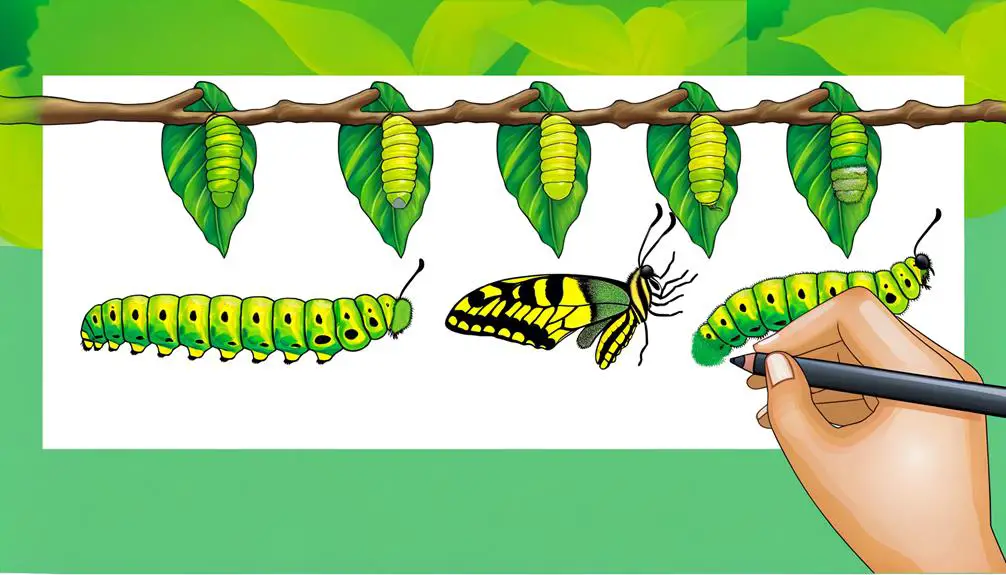
The molting phases of the Yellow Swallowtail butterfly (Papilio glaucus) are characterized by distinct developmental stages, each essential for successful metamorphosis.
Initial larval stages involve frequent ecdysis, driven by rapid cellular growth and nutrient assimilation.
Mid-stage growth spurts necessitate further molting, culminating in the final molt, where the larva shifts into the pupal stage, preparing for eventual emergence as a mature butterfly.
Early Larval Stages
During the early larval stages, the yellow swallowtail butterfly undergoes multiple molting phases, each characterized by significant morphological changes and growth spurts driven by hormonal regulation. These molting phases, also known as instars, are critical for larval development and are influenced by the secretion of ecdysone.
Key observations during these stages include:
- First Instar: The larva emerges, displaying a black coloration with a white saddle, providing camouflage against predators.
- Second Instar: The larva molts, revealing a larger, still primarily black body with reduced white markings.
- Third Instar: Notable for increased size and the appearance of small spines, enhancing defense mechanisms.
- Fourth Instar: The larva exhibits a greener hue, aiding its blending into foliage.
These phases are essential for the caterpillar's survival and preparation for subsequent growth stages.
Mid-Stage Growth Spurts
Mid-stage growth spurts in the yellow swallowtail butterfly are marked by increased metabolic activity, substantial weight gain, and further morphological differentiation essential for the shift from larva to pupa.
During these phases, the larval instars undergo several ecdyses, shedding their exoskeletons to accommodate rapid growth. Each molt results from hormonal regulation, primarily ecdysone, which triggers the complex biochemical processes necessary for exoskeleton renewal.
Observational studies note significant expansion in body segments and the development of distinctive markings. Nutritional intake during this period is critical; the caterpillars exhibit voracious feeding behavior, consuming host plant foliage at accelerated rates.
These mid-stage transformations set the physiological groundwork for the subsequent pupation phase, where metamorphosis will culminate.
Final Molting Process
Initiating the final molting process, the yellow swallowtail butterfly larva undergoes a meticulously regulated sequence of physiological and biochemical changes to prepare for pupation. This critical phase encompasses several stages, each integral to the larva's change into a chrysalis:
- Apolysis: The separation of the old cuticle from the underlying epidermal cells, facilitated by enzymatic activity.
- Ecdysis: The shedding of the old exoskeleton, revealing a soft, new cuticle beneath.
- Sclerotization: The hardening and darkening of the new cuticle through cross-linking of proteins, providing structural integrity.
- Hormonal Regulation: The careful orchestration of ecdysteroids and juvenile hormones, ensuring precise timing of developmental alterations.
These stages exemplify the complex, freedom-driven journey of metamorphosis in the yellow swallowtail butterfly.
Pupal Stage
The pupal stage of the Yellow Swallowtail butterfly, scientifically known as Papilio glaucus, marks a critical period of metamorphosis wherein the caterpillar undergoes significant physiological transformations within a protective chrysalis.
During this stage, the larva forms a pupal shell or chrysalis, characterized by its hardened exoskeleton. Inside the chrysalis, histolysis occurs, breaking down larval tissues, while histogenesis simultaneously constructs adult structures such as wings, antennae, and reproductive organs.
The entire process is governed by hormonal signals, specifically the ecdysone and juvenile hormones, ensuring coordinated development.
Researchers observe that during this stage, the chrysalis remains immobile and camouflaged, offering maximum protection from predators.
This intricate transformation is essential for the butterfly to emerge as a fully developed adult.
Emerging Butterfly
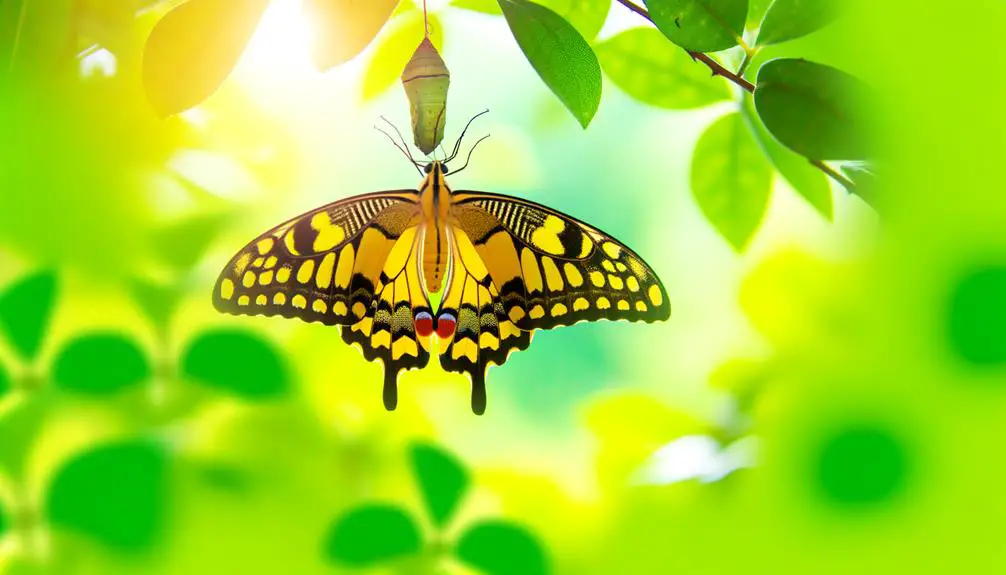
Upon completing its pupal stage, the Yellow Swallowtail butterfly begins the process of eclosion, wherein it meticulously breaks free from the chrysalis to emerge as an adult. This critical phase involves several sequential steps:
- Chrysalis Rupture: The butterfly exerts pressure to split the chrysalis using specialized enzymes and physical force.
- Emergence: The butterfly slowly pulls itself out, exposing its crumpled wings and soft body.
- Wing Expansion: Hemolymph is pumped into the wings, causing them to expand and harden.
- Resting Period: The butterfly remains stationary, allowing its wings to dry and its exoskeleton to solidify.
This emergence marks a pivotal change from an immobile state to newfound mobility, symbolizing the butterfly's journey towards freedom and exploration.
Adult Life
During the adult life stage, the Yellow Swallowtail butterfly prioritizes mating and reproduction, engaging in intricate courtship behaviors and utilizing pheromones for mate attraction.
Concurrently, adults sustain themselves by feeding on nectar from various flowering plants, relying on specific nectar sources that provide essential nutrients for energy and longevity.
Observations indicate that these behaviors are vital for ensuring species propagation and survival.
Mating and Reproduction
Emerging from their chrysalises, adult Yellow Swallowtail butterflies engage in intricate courtship behaviors that are essential for successful mating and reproduction. These behaviors include:
- Chemical Signaling: Males release pheromones to attract females, a process crucial for mate recognition.
- Visual Displays: Males perform aerial displays, showcasing their vibrant wings to potential mates.
- Territoriality: Males establish and defend territories to enhance their chances of encountering receptive females.
- Copulation: Once a female accepts a male, they engage in copulation, transferring sperm via the male's aedeagus to the female's bursa copulatrix.
These behaviors guarantee the propagation of the species, with successful mating leading to the fertilization of eggs, which the female will later deposit on suitable host plants.
Feeding and Nectar Sources
Adult Yellow Swallowtail butterflies primarily sustain themselves by feeding on nectar from a variety of flowering plants, which provide essential sugars and nutrients necessary for their energy-intensive activities. These butterflies exhibit a preference for specific floral species, guided by the availability of nectar and flower morphology conducive to their proboscis. Key nectar sources include plants from the Apiaceae, Asteraceae, and Fabaceae families. Research highlights the significance of these nectar sources in supporting their metabolic functions and reproductive success.
| Plant Family | Common Species | Nectar Availability |
|---|---|---|
| Apiaceae | Queen Anne's Lace | High |
| Asteraceae | Milkweed | Moderate |
| Fabaceae | Red Clover | High |
| Rosaceae | Wild Rose | Moderate |
| Caprifoliaceae | Honeysuckle | High |
Such diversity in nectar sources underscores the adaptive foraging strategies of the Yellow Swallowtail.
Conclusion
In the grand irony of nature, the yellow swallowtail butterfly’s life cycle—from egg to larva, through the molting phases, and culminating in the emergence of the adult butterfly—exemplifies an intricate dance of metamorphosis. This transformation is not only a marvel of biology but also a testament to nature’s complexity and precision. Similar to the orchard swallowtail butterfly life cycle, each stage serves a crucial role in development, ensuring survival and adaptation. The adult butterfly, with its striking wings, emerges to fulfill its role in pollination and reproduction, continuing the cycle once more.
Despite the detailed and laborious processes of growth, feeding, and transformation, the adult butterfly's existence is fleeting, often lasting only a few weeks.
This ephemeral beauty underscores the paradox of a complex life cycle devoted to such a transient moment of splendor.

